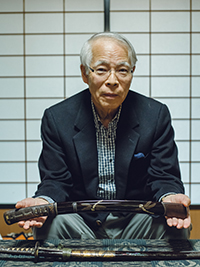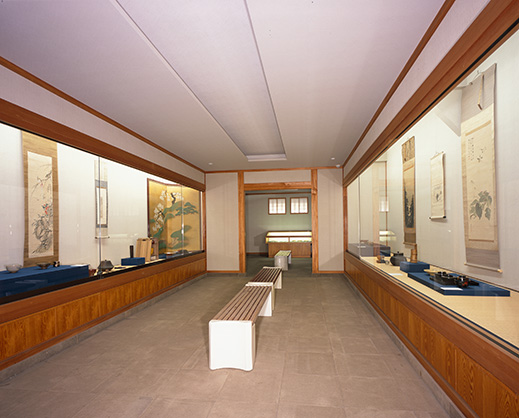 |
Focus features two in-depth reviews each month of fine art, architecture and design exhibitions and events at art museums, galleries and alternative spaces around Japan. The contributors are non-Japanese residents of Japan. |
|
|
 |
 |
 |
The Tezen Museum: Window on the Rich Culture of Izumo
Alice Gordenker |
 |
The Tezen Museum in Izumo, Shimane Prefecture. |
The Grand Shrine of Izumo is one of the oldest and most important Shinto shrines in Japan. It is also the top tourist destination in Shimane Prefecture, drawing as many as eight million visitors annually to the small town of Izumo, situated 34 kilometers west of Matsue, the prefectural capital. Yet most visitors move on after paying their respects at the shrine, missing out on the opportunity to learn about the surrounding city. This is a shame, as just a short walk from the shrine is a charming museum that offers a window on the rich traditional arts and culture of the Izumo region.
|
 |
|
|
|
Museum chairman and 11th-generation patriarch Hakusaburo Tezen. The scabbard in his hands was collected by a relative during the Edo period and is richly decorated with inlay. (Photo by Irwin Wong) |
The Tezen Museum was established in 1993 to share and conserve a treasure trove of artworks, crafts, and historical documents passed down through the generations of an important local household. The Tezen family, who have lived on the museum site since 1686, were once merchants dealing in corn, cotton and lumber, and were official purveyors to their samurai rulers. They also ran a sake brewery that produced rice wine both for general consumption and as omiki, the sacramental sake used in offerings at the Grand Shrine of Izumo. Members of the family served as local elders as well as stewards of the official inns reserved for high-ranking visitors to the shrine. Although not themselves of samurai rank, they were granted the privilege of wearing swords and bearing a surname as symbols of the family's relatively lofty status.
Thanks in part to such high connections, over the years the family came into possession of a number of particularly fine artworks, including a pair of six-fold screens painted by the Edo-era eccentric Shohaku Soga (1730-1781) and seven works (six scrolls and a folding screen) by Yusei Horie (1802-1873), one of the most celebrated painters of Shimane. These and other treasures go on display in rotation in the first gallery near the museum entrance, a converted rice storehouse, as part of special exhibitions that change three or four times a year.
 |
|
The first gallery is used for changing exhibitions of treasures from the family collection, including paintings, swords and utensils for the tea ceremony. |
The second and much more expansive gallery is the former sake brewery, scaled down during its conversion into exhibition space, but still a large and impressive example of traditional architecture. This area houses a permanent exhibition of traditional crafts of the Izumo region. During the Edo period (1603-1867), the samurai clans that ruled the separate and semi-autonomous provinces of Japan often operated official kilns and craft workshops, to ensure local supply and goods for trade, but also to produce official gifts to be presented as tribute to the shogun and other high-ranking dignitaries.
Many of the pieces in the second gallery date from an artistic renaissance that took place under Harusato Matsudaira (1751-1818), the seventh hereditary lord of the Matsue clan that ruled over Izumo and environs. An enlightened leader who instituted reforms to improve the lives of his subjects and stabilize the once-troubled finances of the clan, he was also a patron of the arts and a famed practitioner of the tea ceremony.
 |
|
Once a sake brewery, the second gallery houses a permanent exhibition of local ceramics and lacquerware, as well as hundreds of items for daily use dating from the 17th to 19th centuries. |
There are two main types of ceramics associated with Izumo: Rakuzan ware, which has a rustic look, and the livelier Fujina ware, which is characterized by bright glazes in blue, black and a distinctive yellow, and was exported to the West in some quantity during the 19th and early 20th centuries. Nevertheless, it is difficult to find examples of Izumo ware in Western museums, and it is often confused with ceramics produced in other parts of Japan. The Tezen Museum has one of the best and most comprehensive collections of Izumo ware, including some remarkable pieces of very high quality.
Rakuzan ware takes its name from a place where the Matsudaira lords maintained a villa east of Matsue castle. The kiln was founded around 1640, but ceased operations for a time towards the end of the next century. Production was revived in 1801 by Harusato Matsudaira, who directed the potters to specialize in renditions of the Korean-style tea ware he favored. Fujina ware was developed somewhat later, in the early 1700s, first by a family of potters named Fujiki who at their peak operated as many as nine kilns in and around the village of Fujina. Soon other families became involved. The village initially made items for general use, but later an official kiln with clan sponsorship was established to produce Fujina ware of higher quality.
|
 |
|
|
|
Persimmon-shaped incense holder used in the tea ceremony, in the distinctive yellow of Fujina ware. Early 19th century. |
When the feudal system was abolished with the Meiji Restoration of 1868, the kilns lost official support and were forced to find new markets. The Fujina potters began turning out products for overseas markets, and for a time exports flourished. One of the more surprising exhibits in the Tezen collection is a Fujina ware Western-style tea set that closely imitates Limoges porcelain, yet is made of regular pottery. Today, there are just two kilns carrying on the tradition of Izumo ceramics: the Unzen-gama kiln in Fujina, which makes Fujina ware, and the Izumoyaki Rakuzan-gama, which makes Rakuzan ware.
Visitors to the Tezen Museum can also see locally crafted lacquerware, including examples made by the Kojima family of lacquer painters, who were originally invited from Kyoto as official artists to the Matsue clan. The fifth-generation master accompanied his lord, Harusato, to Edo (present-day Tokyo), where he studied with Yoyusai Hara, the most accomplished lacquer painter of the day. Upon his return to Izumo, he produced a tea caddy that so pleased his master that he was granted the honorary name Shikkosai. The museum's collection includes a particularly fine piece made by his son, Shikkosai II, a three-tiered confection box with intricate maki-e decoration in gold and silver. The brushwork on the elegant tied cord design is so fine that one can distinguish even the individual threads of the tassels.
|
 |
|
|
|
Burnished lacquer three-tier confectionery box with tied cord design (togidashi musubihimo maki-e sandan kashiki) by Shikkosai Kojima II. Late Edo period. |
The second gallery also displays several hundred articles for everyday use that date from the Edo period to the early Showa period. Standouts include a bridal trousseau brought by a woman who married into the family in 1890, including an assortment of intricate silver hairpins (kanzashi) designed so individual ornaments can be affixed to the end. The most charming of these baubles is a miniature copy of the pulley-system seen over wells, complete with a finely worked chain that runs through the pulley so that the tiny water buckets on either end move up and down.
The museum provides limited English explanation, with most exhibits captioned only in Japanese. Be sure to pick up the binder that sits on a bench in the second gallery and provides further explanation and identification in English of the permanent exhibition. Also, visitors are advised to dress for the season as the gallery has neither heat nor air-conditioning, and can be chilly in the winter and warm in the summer.
Unless otherwise indicated, photographs are courtesy of the Tezen Museum.
|
 |
 |
| Tezen Museum |
2450-1 Kizuki-nishi, Taisha-cho, Izumo-shi, Shimane Prefecture
Phone: (0853) 53-2000 |
|
|
 |
 |
Alice Gordenker
Alice Gordenker is a writer and translator based in Tokyo, where she has lived for more than 18 years. For over a decade, she penned the "So, What the Heck Is That?" column for The Japan Times, providing in-depth reports on everything from industrial safety to traditional talismans. She translates and consults for museums, and has a special interest in making Japanese museums more accessible for visitors from other countries. |
|
 |
|